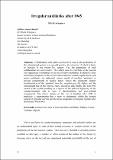Files in this item
Irregular auxiliaries after 1945
Item metadata
| dc.contributor.author | Scheipers, Sibylle | |
| dc.date.accessioned | 2018-11-10T00:48:35Z | |
| dc.date.available | 2018-11-10T00:48:35Z | |
| dc.date.issued | 2017 | |
| dc.identifier | 249429326 | |
| dc.identifier | 42deb85e-976d-44e8-bc32-3afbc23d537c | |
| dc.identifier | 84966702432 | |
| dc.identifier | 000396483400002 | |
| dc.identifier.citation | Scheipers , S 2017 , ' Irregular auxiliaries after 1945 ' , The International History Review , vol. 39 , no. 1 , pp. 14-29 . https://doi.org/10.1080/07075332.2016.1179206 | en |
| dc.identifier.issn | 0707-5332 | |
| dc.identifier.other | ORCID: /0000-0001-8080-3337/work/76386920 | |
| dc.identifier.uri | https://hdl.handle.net/10023/16429 | |
| dc.description.abstract | Collaboration with native auxiliaries in wars in the peripheries of the international system is an age-old practice, the relevance of which is likely to increase in the twenty-first century. Yet, the parameters of such collaboration are understudied. This article aims to contribute to the nascent yet fragmentary scholarship on the use of native auxiliaries. It identifies three intellectual templates of the collaboration between Western regular forces and native auxiliaries: the eighteenth-century model of auxiliary ‘partisans’ as tactical complements to regular armed forces; the nineteenth-century transformation of the ‘partisan’ into the irregular guerrilla fighter and the concomitant rise of the ‘martial races’ discourse; and, finally, the post-1945 model of the loyalist auxiliary as a symbol of the political legitimacy of the counter-insurgent side in wars of decolonisation and post-colonial insurgencies. The article focuses on the rise of loyalism after 1945 in particular, a phenomenon that it seeks to understand within the broader context of irregular warfare and the moral reappraisal of irregular fighters after the Second World War. | |
| dc.format.extent | 488002 | |
| dc.language.iso | eng | |
| dc.relation.ispartof | The International History Review | en |
| dc.subject | Colonial war | en |
| dc.subject | Wars of decolonisation | en |
| dc.subject | Auxiliaries | en |
| dc.subject | Malaya | en |
| dc.subject | Kenya | en |
| dc.subject | Vietnam | en |
| dc.subject | Algeria | en |
| dc.subject | T-NDAS | en |
| dc.subject | SDG 16 - Peace, Justice and Strong Institutions | en |
| dc.title | Irregular auxiliaries after 1945 | en |
| dc.type | Journal article | en |
| dc.contributor.institution | University of St Andrews. School of International Relations | en |
| dc.identifier.doi | https://doi.org/10.1080/07075332.2016.1179206 | |
| dc.description.status | Peer reviewed | en |
| dc.date.embargoedUntil | 2017-11-10 |
This item appears in the following Collection(s)
Items in the St Andrews Research Repository are protected by copyright, with all rights reserved, unless otherwise indicated.

